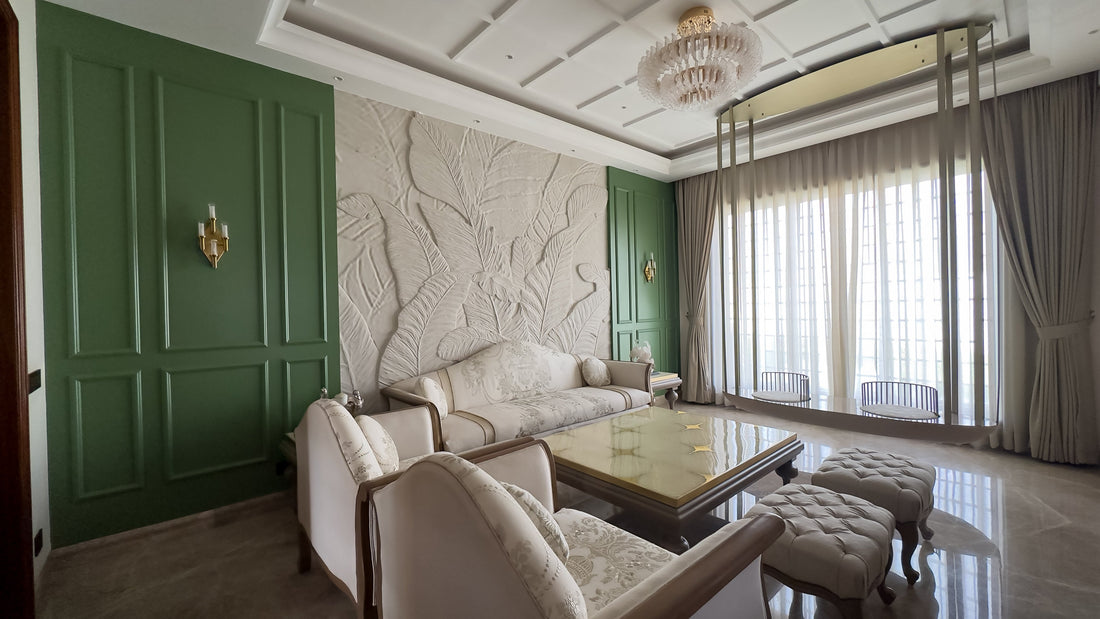
The Impact of Texture in Bespoke Interiors
Sai SandeepShare
I. Introduction
Ever walked into a room and instantly felt its warmth and richness, while another space felt flat and uninspiring? The secret often lies in texture. In bespoke interiors, texture is a subtle yet powerful design tool that adds dimension, emotion, and tactile richness to your space. This blog explores how texture shapes our experience of a space and how you can use it intentionally in your custom interiors.
II. What Is Texture in Interior Design?
Texture refers to the surface quality of materials—how something feels and looks. It encompasses:
-
Tactile Texture: The actual feel of a surface, such as the softness of velvet or the graininess of wood.
-
Visual Texture: The perceived texture of a surface, which might appear rough or smooth due to patterns or finishes, even if the surface is uniform to the touch.
In bespoke design, unlike mass-produced interiors, there's an opportunity to thoughtfully layer textures throughout the space, creating a rich and engaging environment.
III. Why Texture Matters in Bespoke Interiors

-
Adds Depth and Dimension: Texture introduces layers that prevent a space from feeling flat or sterile. By combining different textures, designers can create a dynamic and inviting atmosphere. (Claire Collins Interiors)
-
Creates Mood and Warmth: Soft textures like plush rugs and cozy throws add warmth and comfort, making a space more inviting. Conversely, sleek surfaces can impart a formal or modern feel. (Claire Collins Interiors)
-
Enhances Functionality: Certain textures are more forgiving and can hide wear and tear better. For instance, a bouclé fabric might mask stains more effectively than silk.
-
Amplifies Personalization: Textures tell a tactile story unique to the homeowner, reflecting personal tastes and experiences.
IV. Ways to Incorporate Texture in Bespoke Interiors
-
Soft Furnishings: Incorporate upholstery, cushions, throws, and curtains. For example, pairing velvet cushions with a linen sofa creates a pleasing contrast.
-
Walls & Finishes: Use textured wallpapers, exposed brick, limewash, or paneling. Custom wall treatments can provide a bespoke feel without adding clutter.
-
Flooring & Rugs: Layer rugs over wood or stone floors to add softness and warmth. Materials like jute, wool, and silk each offer different textural experiences.
-
Natural Elements: Incorporate wood, stone, rattan, leather, and metal for organic variety. Bespoke furniture made from reclaimed or live-edge materials brings raw texture into the home.
-
Art & Accessories: Add sculptural elements, woven baskets, textured ceramics, and handwoven tapestries. Bespoke decor often includes artisanal pieces with handcrafted finishes.
V. Artvikta’s Approach to Textural Balance
At Artvikta Studio, our signature style involves the intentional layering of materials to create harmony and visual rhythm. Each room is curated with a blend of matte and glossy, smooth and rough, hard and soft textures.
For instance, in one of our projects, we combined rough limewashed walls with smooth walnut cabinetry and soft wool textiles to achieve a balanced and inviting space. We prioritize sourcing locally-made, sustainable textures to add meaning and authenticity to our designs.
VI. Tips for Using Texture in Your Own Home

-
Aim for Contrast and Balance: Avoid overusing one type of texture. Mix different textures to create a balanced and engaging space.
-
Highlight Textures with a Neutral Palette: If you're not using bold colors, a neutral palette can allow textures to stand out and add interest.(Castlery)
-
Consider Tactile Experience: Choose materials that you'll enjoy touching daily. Sit, walk, and lean on different textures to see how they feel.
-
Mix Materials Within Furniture: Combine materials like metal and leather in a single furniture piece to add depth and interest.
VII. Conclusion: Texture as a Silent Storyteller
Texture brings life, comfort, and individuality to bespoke interiors. It's the silent storyteller that engages our senses and adds depth to our living spaces.
Final Thought: “When design speaks not just to your eyes but also your hands, that’s when a house truly becomes a home.”
Want a home that feels as good as it looks? Let Artvikta Studio design a richly textured, custom-crafted space just for you.
For further reading on bespoke interiors and sustainable design, explore our related articles:
